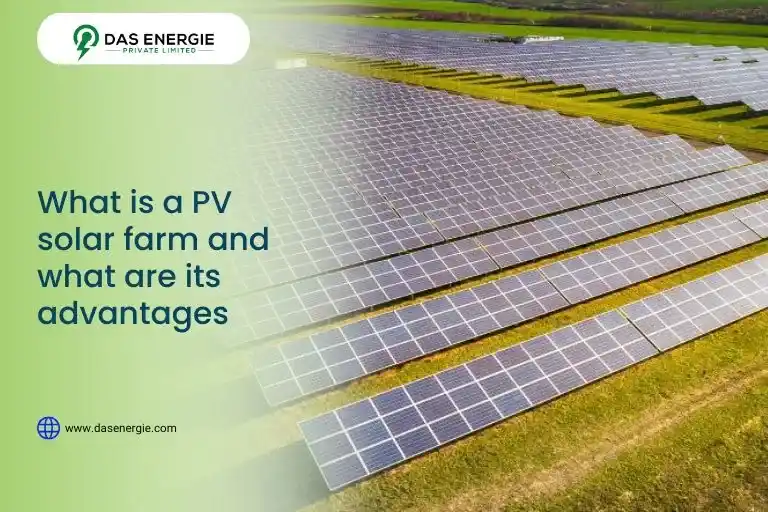


Most parts of India receive solar radiation of 4 to 7 kWh per sq. metre/day. If even a fraction of this energy is utilised as solar electricity, it can fulfil India’s entire power requirements.
A PV solar farm is a large assembly of solar panels which are installed over a large area. They harness solar electricity to meet the electricity needs of households and businesses.
Table of Contents
ToggleSolar farms are broadly divided into 2 categories:
These are commercial solar farms with lakhs of solar panels. Utility-scale solar farms enter into power purchase agreements (PPAs) with DISCOMs to sell them power. This power can be used to power homes and businesses, and run public services such as the Delhi Metro.
Notable utility-scale solar farms in India include Bhadla Solar Park, Khavda Solar Park and the Rewa Ultra Mega Solar Park.
In India, large solar parks with a capacity of at least 500 MW are developed by an implementing agency called Solar Power Park Developer (SPPD). As per the MNRE, there are 8 different methods of selecting the SPPDs.
Community solar farms are installed close to a local community of homes and businesses. It targets those who cannot afford a rooftop solar system or can’t install one due to some reason. There are 2 different models of community solar:
The following are the major PV solar farm components:
Solar panels are like the engines of a solar system. They generate electricity from sunlight and send the solar electricity to the grid.
A mounting structure is the skeleton of a solar system. It holds the solar panels in place and makes sure they are safe and secure.
A solar panel’s productivity is maximum when the sunlight falls perpendicularly on the solar panels. When solar trackers are installed in mounting structures, it ensures that the solar panels are facing the sun so that sunlight falls perpendicularly on the solar panels.
You cannot use direct current (DC) to power your appliances. But this is what a solar farm generates. To make it usable, it must be converted to alternating current (AC). Inverters are installed to perform the crucial function of DC-to-AC conversion.
To reduce power losses during transmission, the transformer increases the voltage of the solar electricity before the power is sent to the grid.
Wires are important for connecting different components of the solar system such as solar panels, inverters, etc.
There are 2 different types of solar farm designs:
In these types of solar farms, the mounting structure is either directly installed on the ground or on a concrete platform on the ground.
A floating solar farm has a mounting structure which floats on a water body. The cooling effect of the water underneath further increases the efficiency of the solar systems.
The most important component of a photovoltaic solar farm are the solar panels. These solar panels comprise solar cells made of silicon. To allow electricity to flow through the cells, these cells are doped with impurities such as boron and phosphorous.
The photovoltaic effect is used to generate electricity in a solar system. As the sunlight falls on the solar panels, it creates a voltage difference which makes the electrons flow through the solar system.
This solar electricity is direct current. Inverters convert it into alternating current which is then sent to a transformer for increasing its voltage. Finally, it is sent to a substation from where it is exported to a DISCOM’s grid.
Here are the stages for building a PV solar farm:
The first step in setting up a photovoltaic solar farm is to select the land where it will be installed. The 2 most important things in this regard are the solar radiation incident at the place and the available area.
The solar park implementing agency has to get permission from the central and state governments to develop it.
Land for the solar park is acquired either via purchase or leasing. Landowners are compensated as per the market price of the land. It is preferable that the land is barren or government land as there will be little or no cost for land acquisition.
Sometimes the implementing agency conducts tests to check the quality of the soil and judge seismic activity at the place.
The implementing agency conducts auctions for solar projects at the PV panel solar panel farms. Developers from both private and public sectors bid to develop solar projects at the park.
Construction of the solar farm design includes installing solar mounting structures, solar panels, wires, inverters, solar trackers, transformers, earthing, offices, toilets, and storage rooms.
Once the solar park has been built, the implementing agency officially commissions it to generate solar electricity. Thus the power generation begins.
The construction of a PV solar farm entails an expenditure of thousands of crores of rupees. For example, the Pavagada Solar Park was built for Rs. 16,500 crore. The Charanka Solar Park was built for more than Rs. 5,365 crore.
Developers at utility-scale solar parks earn profits by selling PV solar farm power to DISCOMs at fixed tariffs. Once a solar park developer recovers their initial investment and the cost of operating and maintaining the solar park, they start earning profits. For example, the 750 MW Rewa Ultra Mega Solar Park achieved a first-year tariff of Rs. 2.97/unit and a tariff of Rs. 3.3/unit over 25 years.
On the other hand, community solar farms are a form of cooperative. They are non-profits whose sole purpose is to serve the local community.
The Ministry of New and Renewable started the “Development of Solar Parks and Ultra Mega Solar Power Projects” scheme in December 2014. Under the scheme, subsidies are provided to solar farms with a capacity of at least 500 MW.
As per the government, a maximum of Rs. 25 lakh is provided to a solar farm to prepare the Detailed Project Report (DPR). Rs. 20 lakh per MW or 30% of the project cost, whichever is lower, is granted on accomplishing prescribed milestones.
Here’s a list of the largest PV solar farms in India:
You can read our blog on India’s largest solar power plants to learn more about them.
Though solar farms generate clean and renewable energy, they have some disadvantages as well:
Several pieces of equipment are used in a PV solar farm such as inverters, solar panels, transformers, etc. Disposing them at the end of their lifespan presents a challenge. They can produce several chemicals that can damage the environment. It is best to recycle them if possible.
A solar farm can affect the local habitat and the flora and fauna inhabiting it. It can disturb the life cycle and population of a species.
Land that is used to set up a PV solar farm could also be used for farming. That’s why, it is best to use barren, infertile land to develop solar farms. Otherwise, the nation’s food security could be at risk.
PV solar farms can reduce the cost of electricity in the long run. They generate clean and green energy which will help India meet its international climate change targets. As fossil fuels are non-renewable, it is important to look for other avenues for energy generation which are sustainable.
A solar farm design shows the layout of the solar farm which will be developed in an area.
The central government provides subsidies for developing solar parks under the “Development of Solar Parks and Ultra Mega Solar Power Projects” scheme.
The main components of PV panel solar panel farms are solar panels, inverters, transformers, and mounting structures.
Currently, the largest solar farm in India is the Bhadla Solar Park. But it will be overtaken by the Khavda Solar Park in the future.
Mr Das’ expertise spans various aspects of solar energy, including photovoltaic technology, solar thermal systems, and energy storage solutions. He contributes profusely to our blogs to share his keen knowledge and expertise with those seeking information regarding solar system installation. He brings a wealth of practical knowledge and real-world experience to his writing. His articles offer valuable guidance on navigating the intricacies of solar energy projects, from site assessment and system sizing to financing options and maintenance strategies.
